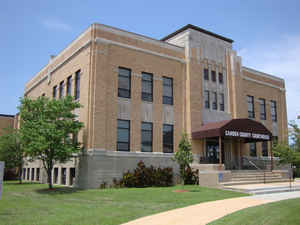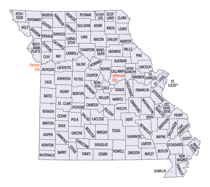Missouri Counties
Missouri has one hundred and fourteen counties and one independent city. St. Louis City is separate from St. Louis County and is referred to as a "city not within a county." Following the Louisiana Purchase and the admittance of Louisiana into the United States in 1812, five counties were formed out of the Missouri Territory at the first general assembly. Most subsequent counties were apportioned from these five original counties.Camden County, Missouri
Camden County Education, Geography, and History
Camden County is a county located in the state of Missouri. As of the 2010 US Census, the population was 44,002. Its county seat is Camdenton. The county was organized January 29, 1841 as Kinderhook County and renamed in 1843 for Charles Pratt, 1st Earl Camden, Lord Chancellor of the United Kingdom, and leader of the Whig Party.
Etymology - Origin of Camden County Name
Originally organized in 1841 as Kinderhook County in honor of President Martin Van Buren's New York home. The name was changed to Camden on February 23, 1843.
Demographics:
County QuickFacts: CensusBureau Quick Facts
History of Camden County
One of the south central counties of Missouri, on the northern slope of the Ozark Range of mountains. It is bounded on the north by Morgan County, on the northeast by Miller County, on the east by Pulaski County, on the south by Laclede and Dallas Counties, and on the west by Hickory and Benton Counties. It was organized January 29, 1841, under the name of Kinderhook County. The name was changed by act of the legislature to Camden County on February 23, 1843. On December 13, 1855, when Laclede County was organized, its southern boundary was moved northward, thus reducing the size of Russell and Warren townships. The name Kindehook was borrowed from Kinderhook, New York, an old Dutch town in Columbia County near the Hudson River, not far from Albany. The name is an anglicized form of the Dutch Kinderhoeck, meaning "children's point," and according to Gannett was bestowed by Henry Hudson upon the place on account of the many Indian children he observed there. The reason for its adoption, as well as for its rejection two years later, must be sought in a dramatic chapter of American politics. It was the home of Martin Van Buren (1782-1862), eighth president of the United States (1837-1841). There Van Buren was born and died; there he resided for the greater part of his life; and therefore the name of the town became a political watchword and rallying-cry for the Democratic Party, especially in the stirring campaign of 1840. The newly organized Missouri county was overwhelmingly Democratic in its sympathies, and would probably have desired to be named Van Buren County, had not that name been already appropriated in 1835 by the western county now known as Cass. In 1835 Van Buren was only Vice-President, serving under Andrew Jackson, but was already taking over the leadership of the party. In 1840 he had presided over the nation for four years and was running for reelection in a campaign that in some ways was the most remarkable one that our country has ever experienced. The campaign made Kinderhook, usually known affectionately as"Old Kinderhook," a symbol for the cause its sons represented from one end of the country to the other. Of especial interest to the student of the American language is a theory recently put forward that finds in the 1840 political battle cry of "Old Kinderhook" the true origin of the popular Americanism "O.K." Mr. Allen Walker Read in a recent article, has presented the case for this new explanation of the source of "O.K." most convincingly, as over against a wilderness of claims and counter-claims in favor of other sources. One of the chief means, he says, adopted by the Democratic Party in New York City, especially by its radical "Locofoco" branch, of furthering Van Buren's candidacy was the organization of a set of social clubs; and among them was one announced for the first time on March 24, 1840, as the "Democratic O.K. Club"--the very first time the magic letters "O.K." ever appeared. The meaning of the name, in keeping with political practices of the time, was kept for a while a profound secret; but it was at once recognized as the watchword of the "New Era," as Van Buren's cause was entitled. The Whigs promptly attacked this secret Locofoco slogan by satirically attributing many meanings to it, among them the apocryphal story so often since repeated that it stood for Andrew Jackson's illiterate spelling of "Oll Korrect." Late in May, however, the Locofocs felt free to divulge its original significance as standing for the birthplace of their adored leader. As the campaign grew hot in the fall of 1840, the expression swept over the entire country, reaching Ohio, for instance early in September. Undoubtedly it must have been deeply imbedded in the hearts of the fervently Democratic Missouri legislature in January, 1841, when they voted to name the latest Missouri county Kinderhook. Van Buren was defeated in the election, however, by his Whig opponent William Henry Harrison, who took office in March, 1841. Just a month later Harrison died, on April 4, 1841, and was succeeded by his Vice-President John Tyler. Both the Whig and the Democratic parties were split and seriously demoralized during the years that followed. When Van Buren ran for the Democratic nomination in 1844, he was defeated by Polk, a man previously almost unknown. By the next election, in 1848, he had deserted the Democrats to become the candidate of the new Free-Soil Party. The Democrats in turn repudiated him, and nominated Lewis Cass, whereupon both candidates were defeated by the Whig nominee General Zachary Taylor, hero of the just concluded Mexican War. These political circumstances supply ample explanation of why the Missourians wanted to change the name of Kinderhook County in 1843, just as they changed the name of Van Buren County to Cass in 1848. The name they chose to replace Kinderhook was Camden, rather a stock name for American places, being borne by counties in North Carolina, Georgia, and New Jersey, and at least twenty towns, among them Camden, South Carolina, where the Battle of Camden was fought August 16, 1780; this was one of the worst defeats suffered by Americans in the Revolutionary War, the British under Cornwallis overwhelmingly the patriot army of General Gates. It was particularly stamped upon American hearts by the death in the battle of the Revolutionary hero, General De Kalb. The popularity of the name Camden in the United States rests ultimately upon the popularity of the British statesman Charles Pratt (1714-1794), the first Earl Camden. He was Lord Chancellor 1766-1770 and one of the ablest leaders of the British Whig Party. During the struggle with the American colonies that arose and came to its fatal conclusion while the Whigs were out of power, Camden was one of their best friends and ablest advocates of the unconstitutionality of "taxation without representation." He led the opposition in Parliament to the Revolutionary War, and naturally was greatly admired in America as a liberal and far-seeing statesman. It is not certain whether the second name of the Missouri county was bestowed directly in honor of the British statesman or not. Gannett states that it was named for Camden County, North Carolina; and it is true that many of its settlers were North Carolinians. They may also have remembered, however, that Earl Camden was a great Whig, although in the British, not the American, sense of the term; and this fact may well have had its significance at a time when American Whigs were winning and all the principles that Kinderhook stood for were being repudiated or forgotten. (Eaton; Gannett; HIST. CAMDEN (1889) 279, 312; HIST. OZARK REG. (1917) 49; ENC. BRIT. (1937); R.M. (1940) 226; MHR, vol. XXXIV (1939-40) 500; Allen Walker Read, THE EVIDENCE ON "O.K.," SAT. REV. OF LIT. XXIV (July 19, 1941) 3-4, 10-11; Dr. R.L. Ramsay)
Source: Overlay, Fauna R. "Place Names Of Five South Central Counties Of Missouri." M.A. thesis., University of Missouri-Columbia, 1943.
Geography: Land and Water
As reported by the Census Bureau, the county has a total area of 709 square miles (1,840 km2), of which 656 square miles (1,700 km2) is
land and 53 square miles (140 km2) (7.4%) is water
Neighboring Counties
Bordering counties are as follows:
- Morgan County (north)
- Miller County (northeast)
- Pulaski County (east)
- Laclede County (southeast)
- Dallas County (southwest)
- Hickory County (west)
- Benton County (northwest)
Education
Public schools
Camdenton R-III School District - Camdenton
Climax Springs R-IV School District - Climax Springs
Macks Creek R-V School District - Macks Creek
Stoutland R-II School District - Stoutland
Private schools
Camden Christian School - Camdenton (PK-12) - Baptist







